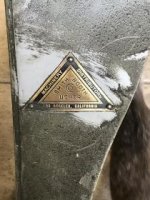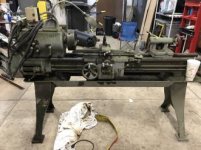Smith, Booth & Usher were the dealers who sold the lathe. John Oder correctly states that the lathe is a LeBlond 13" Regal. This series of lathes is known as the
"Roundhead" Regal. The number 13 on the side of the headstock casting is the swing of the lathe, in inches. The fact that the number is cast on the side of the headstock means the lathe was a "Trainer" model, having a slightly lighter bed casting than the 'standard' Roundhead Regal lathes.
The hollow cast projection on top of the headstock originally held a 'circular slide rule' which had a Bakelite knob. It could give a rough idea of what RPM to run the lathe at for different diameters/different metals. It also had the lever positions on the headstock for the different spindle speeds.
I'd flush the headstock and apron with diesel fuel. Run the headstock under power for a minute or so as well as running the apron with the power feeds engaged, then drain the diesel fuel. I use ISO 68 oil in my own Roundhead Regal lathe headstock and apron. I buy 'tractor hydraulic oil' in 2 gallon jugs at "Tractor Supply". This tractor hydraulic oil is an ISO 68 DTE series oil. DTE = 'dynamo, turbine, engine', which is an oil designation that predates the automobile. DTE series oils are still spec'd and used in powerplant turbines, generator bearings, and some machine tools. DTE oils are a mineral based oil, 'straight weight', tractor hydraulic oil having anti corrosion and antifoaming additives.
Drain plugs for the headstock are located at the bottom of the headstock casting, in between the bedways. The apron should also have a drain plug. There is a plunger pump in the apron which shoots oil up to the 'carriage wings' which slide on the bedways, as well as to the cross slide. This plunger pump has rod about 7/16" diameter which sticks out of the apron running uphill at an angle. The top of this rod has a concave surface, to make a place for your fingertip. Push this rod in and it should spring back out. When you have the diesel fuel in the apron, work this plunger rod quite a few times to push the diesel fuel up and thru the drilled oil passages and out onto the sliding surfaces.
When you refill the apron, work the plunger again until you see oil appear on the bedways and cross slide dovetail.
I add "Lucas Oil Stabilizer" (about 50%) to the oil in the apron. This additive contains nothing harmful to 'yellow metal' (brass or bronze) parts, and adds 'tackifiers' to the oil. This give the oil more of a film strength and 'clinginess'.
The serial number of your lathe will be located on the far end of the bedways, stamped in the flat surface in between the vee way and flat way. If you contact LeBlond Limited (the current incarnation of LeBlond), they will be avble to give you the date your lathe was shipped and who the original purchaser was.
These lathes are about as user-friendly as it gets. The downside is the headstock gears are kind of light. For home shop or light machine shop use, these lathes are fine. However, be mindful of the light gearing and take it easy when doing jobs with interupted cuts or taking heavy hogging cuts on larger diameter work.
These lathes were designed in an era when high speed steel (HSS) tools were in common use, and carbide tools were not all that common. The result is the spindle speeds are on the lower end by today's standards. However, HSS tool bits are cheap at the price and you can grind them freehand on a bench grinder to make your turning, threading, facing and other tools. The HSS tools give you 'two fer one', as you can grind a cutting tool at either end of each HSS tool blank. You can also easily grind form tools from the HSS blanks for things like O ring or retainer ring grooves. A HSS tool, properly ground, finished with some hand-stoning with a small "india Medium Hard' oil stone will give a surface finish that will look like it was precision ground, no further filing of polishing needed. I 'came up' using HSS tools, and was taught to freehand grind lathe tools and twist drills, but that was well over 50 years ago. A word of advice is not to get too hung up on grinding the tools to some exact angle. Aside from threading or form tools which require exact angles, most lathe tools can be ground so their geometry is correct and the angles are not all that critical.
These are good little lathes, and if you are careful and develop your skills, you will be able to get out a surprising range of fine work.




